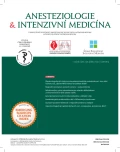Regional anaesthesia for shoulder surgery – new trends
Authors:
D. Mach
Authors‘ workplace:
Anesteziologicko-resuscitační oddělení, Nemocnice Nové Město na Moravě, p. o.
Published in:
Anest. intenziv. Med., 29, 2018, č. 3, s. 128-134
Category:
Review Article
Overview
This review of anaesthetic techniques used in shoulder surgery is based on considerations of the neuroanatomy of the surgical field and describes the traditional methods in anaesthetic care for patients undergoing shoulder surgery. A particularly detailed section of this article is dedicated to the recent developments in the field, especially to peripheral nerve blockades. An additional focus of this review is optimising postoperative analgesia whilst reducing the risk of the phrenic nerve block and ensuring a minimal upper limb motor impairment in the recovery period. The conclusion section discusses the current trend in anaesthetic care for this subgroup of patients.
Keywords:
peripheral nerve block − regional anaesthesia − suprascapular nerve − postoperative analgesia
Sources
1. Memtsoudis SG, Kuo C, Ma Y, et al. Changes in anesthesia-related factors in ambulatory knee and shoulder surgery United States 1996-2006. Reg Anesth Pain Med. 2011;36: 327−333.
2. Peng PW, Chan CHW. Suprascapular nerve block: a narrative review. Reg Anesth Pain Med. 2011;36:358−373.
3. Natsis K, Totlis T, Tsikaras P, et al. Proposal for classification of the suprascapular notch: a studyon 423 dried scapulas. Clin Anat. 2007;20:135−139.
4. Voster W, Lange CPE, Briet RJP, et al. The sensory branch distribution of the suprascapular nerve: An anatomic study. J Shoulder Elbow Surg. 2008;17:500−502.
5. Bigliani LU, Dalsey RM, McCann PD, et al. An anatomical study of the suprascapular nerve. Arthroscopy. 1990;6:301−305.
6. Ozer Y, Grossman JA, Gilbert A. Anatomic observations on the suprascapular nerve. Hand Clin. 1995;11:539−544.
7. Lindberg MF, Grov EK, Gay CL, et al. Pain characteristics and self-rated health after elective orthopaedic surgery—a cross sectional survey. J Clin Nurs. 2013;22:1242–1253.
8. Fredrickson MJ, Krishnan S, Chen CY. Postoperative analgesia for shoulder surgery: a critical appraisal and review of current techniques. Anaesthesia. 2010;65:608–624.
9. Abdallah FW, Halpern SH, Aoyama K, et al. Will the real benefits of single-shot interscalene block please stand up? A systematic review and meta-analysis. Anesth Analg. 2015;120:1114–1129.
10. Hadzic A, Williams BA, Karaca PE, et al. For outpatient rotator cuff surgery, nerve block anesthesia provides superior same-day recovery over general anesthesia. Anesthesiology. 2005;102:1001–1007.
11. Urmey WF, Talts KH, Sharrock NE. One hundred percent incidence of hemidiaphragmatic paresis associated with interscalene brachial plexus anesthesia as diagnosed by ultrasonography. Anesth Analg. 1991;72:498–503.
12. Urmey WF, McDonald M. Hemidiaphragmatic paresis during interscalene brachial plexus block: effects on pulmonary function and chest wall mechanics. Anesth Analg. 1992;74:352–357.
13. Bergmann L, Martini S, Kesselmeier M, et al. Phrenic nerve block caused by interscalene brachial plexus block: breathing effects of different sites of injection. BMC Anesthesiol. 2016;16:45.
14. Kessler J, Schafhalter-Zoppoth I, Gray AT. An ultrasound study of the phrenic nerve in the posterior cervical triangle: implications for the interscalene brachial plexus block. Reg Anesth Pain Med. 2008;33:545–550.
15. Riazi S, Carmichael N, Awad I, et al. Effectoflocal anaesthetic volume (20 vs 5 mL) on the efficacy and respiratory consequences of ultrasound-guided interscalene brachial plexus block. Br J Anaesth. 2008;101:549–556.
16. Sinha SK, Abrams JH, Barnett JT, et al. Decreasing the local anesthetic volume from 20 to 10 mL for ultrasound-guided interscalene block at the cricoid level does not reduce the incidence of hemidiaphragmatic paresis. Reg Anesth Pain Med. 2011;36:17–20.
17. Lee JH, Cho SH, Kim SH, et al. Ropivacaine for ultrasound-guided interscalene block: 5 mL provides similar analgesia but less phrenic nerve paralysis than 10 mL. Can J Anesth. 2011;58:1001–1006.
18. Neal JM, Moore JM, Kopacz DJ, et al. Quantitative analysis of respiratory, motor, and sensory function after supraclavicular block. Anesth Analg. 1998;86:1239–1244.
19. Mak PH, Irwin MG, Ooi CG, et al. Incidence of diaphragmatic paralysis following supraclavicular brachial plexus block and its effect on pulmonary function. Anaesthesia. 2001;56:352–356.
20. Petrar SD, Seltenrich ME, Head SJ, et al. Hemidiaphragmatic paralysis following ultrasound-guided supraclavicular versus infraclavicular brachial plexus blockade: a randomized clinical trial. Reg Anesth Pain Med. 2015;40:133–138.
21. Siegenthaler A, Moriggl B, Mlekusch S, et al. Ultrasound-guided suprascapular nerve block, description of a novel supraclavicular approach. Reg Anesth Pain Med. 2012;37:325–328.
22. Rothe C, Steen-Hansen C, Lund J, et al. Ultrasound-guided block of the suprascapular nerve – a volunteer study of a new proximal approach. Acta Anaesthesiol Scand. 2014;58: 1228–1232.
23. Dhir S, Sondekoppam RV, Sharma R, et al. A Comparison of Combined Suprascapular and Axillary Nerve Blocks to Interscalene Nerve Block for Analgesia in Arthroscopic Shoulder SurgeryAn Equivalence Study. Reg Anesth Pain Med. 2016;41:564–571.
24. Bailie DS, Ellenbecker TS. Severe chondrolysis after shoulder arthroscopy: a case series. J Shoulder Elbow Surg. 2009;18:742–747.
25. Busfield BT, Romero DM. Pain pump use after shoulder arthroscopy as a cause of glenohumeral chondrolysis. Arthroscopy. 2009;25:647–652.
26. Webb ST, Ghosh S. Intra-articular bupivacaine: potentially chondrotoxic? Br J Anaesth. 2009;102:439–441.
27. Gomoll AH, Kang RW, Williams JM, et al. Chondrolysis after continuous intra- articular bupivacaine infusion: an experimental model investigating chondrotoxicity in the rabbit shoulder. Arthroscopy. 2006;22:813–819.
Labels
Anaesthesiology, Resuscitation and Inten Intensive Care MedicineArticle was published in
Anaesthesiology and Intensive Care Medicine

2018 Issue 3
Most read in this issue
- Urgent infraglottic airway – cricothyroid puncture, cricothyrotomy and bougie-assisted cricothyrotomy (BACT)
- Generalizovaný konvulzivní status epilepticus v dětském věku
- Regional anaesthesia for shoulder surgery – new trends
- Corticosteroids in regional anaesthesia and analgesia – state of the art
